Dress of the Gloucestershire Volunteer Artillery
There were artillery units amongst the volunteer corps which sprang up in the days of the Napoleon III and French invasion scares due to the wars against France from the late 18th century through to 1815. The French Revolutionary War was fought between 1792–1797 and again from 1798–1802 and again in the Napoleonic Wars from 1803–1815. These but units were disbanded and the volunteer artillery which were converted into the artillery of the Territorial Force in 1908 date from 1859.
On the 22 November 1859, the Gloucestershire Volunteer Artillery (GVA) was formed by Major H. B. O. Saville, making it's headquarters at the Artillery Ground, Whiteladies Rd. Clifton, Bristol.
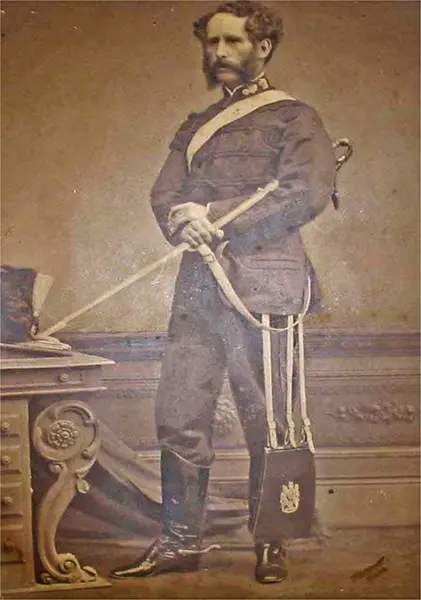
Colonel Henry Bourchier Osborne Savile
Some notes on the above photo:
Notes. 7 Flame Grenade worn on the collar below the Queen's Crown (Victoria) Note also the Busby with silver Grenade and white Cockade. The Sabertache is made of black patent leather with silver Royal Coat of Arms surmounted with a Gun. He also would also wear a pouch on his left shoulder blade attached to the shoulder strap.
From the start the uniform of 1st GVA R.G.A. (Royal Garrison Artillery, 1859) was very much the same as the regular Royal Artillery.
The following is an abstract from dressed regulation of the Corps of 1860:
Full Dress, Officers
Tunic - dark blue cloth, Scarlet collar, cuffs, and edging, trimmed with black cord on breast similar to light infantry, six rows for field officers, 5 for Captain and four for subalterns, with crows feet on back seam. The Australian knot on skirt, and bearing the regulation badges of rank for the Army on the collar in silver and on the cuffs and collar in black braid.
Trousers - dark blue cloth with starlet strike 1 3/4" wide down the outer seam.
Head Dress - Busby - same as worn by the Royal Artillery with silver instead of gold ornaments.
Sword - Regulation Light Cavalry.
Sword knot.- Brown leather with acorn.
Sword belt. - White patent leather with sling, plate silver.
Pouch - Black patent leather with silver gun on it.
Pouch belt - White patent leather two inches wide, with out buckle or ornament.
Undress Dress, Officers
Undress uniforms were worn for semi-formal or ordinary duty occasions in the late 19th century.
Jacket - plain dark blue double breasted pilot, reaching two or three inches below point of hips, to be worn with collar turned down, showing a scarlet waistcoat, black Silk buttons four each side, no braid on sleeves.
Waistcoat - Scarlet cloth with two lines of black tracing cord round the edge, the outer line plain, the second line in small circles within, and a row of bronze studs down the front, hook and eye.
Trousers - Same as full dress.
Forage cap - Blue cloth band of two inch mohair braid embroidered Silver Grenade in front, French Peak.
words and belts - Same as full dress, but the sword belt to be worn under the coat.
Full Dress, Other Ranks
Tunic - Same as officers but without the collar badges. An Austrian knot on the cuff, and three rows of cord on breast. Distinguishing Badges:
Serjeant - gun and crown in silver on both arms.
Corporals - Crossed swords in silver on both arms.
Trousers - Same as officers.
Head Dress - Busby, Artillery Patten, with silver ornaments - silver grenade and a 12 inch plume of horse hair to be worn in the grenade.
Sword - Serjeant’s, same as for officers, for rank and file, sword bayonet with steel scabbard, or short sword with steel scabbard.
Sword belt - Sergeant’s as for officers, lion head clasp. For rank and file white patent leather, with frog and snake clasp.
Pouch - Plain black leather.
Pouch belt - White patent leather.
Gloves - White leather.
Undress Dress, Other Ranks
Jacket - same as for officers, except that the collar is to be lined with scarlet cloth and worn erect when on parade.
Waistcoat - None, except for private use, when the same as officers may be adopted.
Trousers - Same as for dress.
Forage Cap - Serjeant’s, same as officers with German silver grenade. Rank and file blue cloth, band scarlet, small German silver grenade in front and a French peak.
Swords and Belts - Serjeant‘s Same as full dress, but the sword belt to be worn under the coat. Rank and file, same as full dress, but the pouch belt only to be worn at undress parades.
A regimental shell jacket for serjeant’s and officers of the following pattern has been adopted, vis. Plain dark blue with scarlet collar and edging of black tracing cord, fastened at the breast with hooks and eyes for officers, and black buttons with a crown for serjeant’s - but it is intended for private use, and it not to be worn at commanding officers parades, when the owner has provided himself with the regimental undress jacket.
Cloak - Plain blue Inverness cape lined with white.
Most of the original corps were small of only of battery strength, and were alone, these small corps were then collected into administrative brigades and by 1880 the administration brigades had been formed into corps of brigade strength.This meant that some alteration to uniforms, badges and buttons had to be made. Badges and buttons were in white metal and officers lace was in silver.
After 1878 other ranks wore the Austrian knot in scarlet on the sleeves of their tunics such as on the tunic held by 266 GVA Bty (V). Various devices were worn on the busby grenade, with a white horse hair cockade.
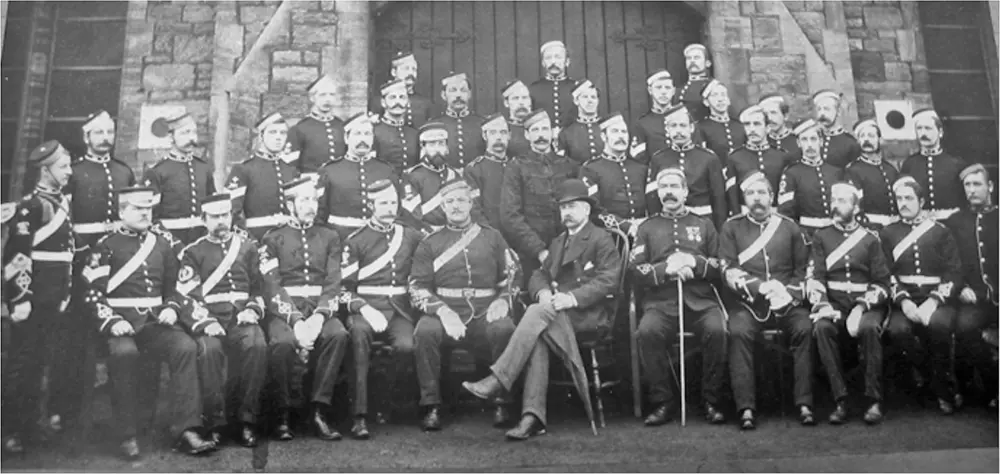
W.O.s and Staff Sgts and Sgts mess (Col. A. Versturme in civilian cloths)
Notes on the above photo: The badges of rank worn by the front rank, also the handlebar moustaches and the beard of one man who wears the rank of Sgt, who along with two other men wears a peak hat,(front row assume to be regulars) the others wear a pillbox hat. The man directly behind the Colonel in the picture is wearing an officers dark blue uniform. The Adjutant perhaps?. He has four lines of cord? decoration on the front of his jacket, so he is a Captain.
On converting to Territorials in 1908, the busby was replaced with the helmet which was very much like the police helmet. Helmet plates worn on the front of the helmet were the same as regular army plates but were of white metal and the mottoes were replaced by a blank scroll where those of today's date show UBIQUE or the badge may have shown a Laurel spray. the motto scroll below the gun would then have had Artillery Volunteers or Volunteer Artillery within the Scroll. Silver badges held in the officers mess as menu holders show GVA in the top scroll.
After the introduction of service dress in 1902 the badge worn on the service dress cap, forage cap and pouch was the same as the regular army but with Volunteers on the upper scroll. The officers service dress cap badge was in bronze, the other ranks was in white metal. Since 1880 other ranks had worn the universal grenade in white metal on the collars of their tunics. Officers wore the service dress collar grenade without the scroll.
The early shoulder titles on the epaulet's were simply the initials of the corps, e.g. 1st GVA for the 1st Gloucestershire Volunteer Artillery, this like the piping of the uniform and the Austrian Knot was in red.
In 1908 the Territorial Force was created, and many of its original units were formed from and carried on the traditions of disbanded volunteer corps. The uniform of the R.A. (T.F.) was similar to that of the R.A., buttons and badges being in gilt or gilding metal and lace being of gold, but the motto Ubique was not granted. the helmet plate and cap badge had a laurel spay in place of Ubique on the top scroll and the officers' collar grenade had no scroll below it. Officers wore the letter "T" below their rank badges or, with service dress, below their collar badges and other ranks wore a "T" above their shoulder titles. The early titles had the designation of the unit added e.g. T over RFA over Gloucestershire later the designation was omitted.
In August 1908, gold braid and badges substituted for the Volunteer Silver pattern badges. In 1909, all buff equipment and blue greatcoats were withdrawn and khaki greatcoats issued, and in 1912, busbies were withdrawn.
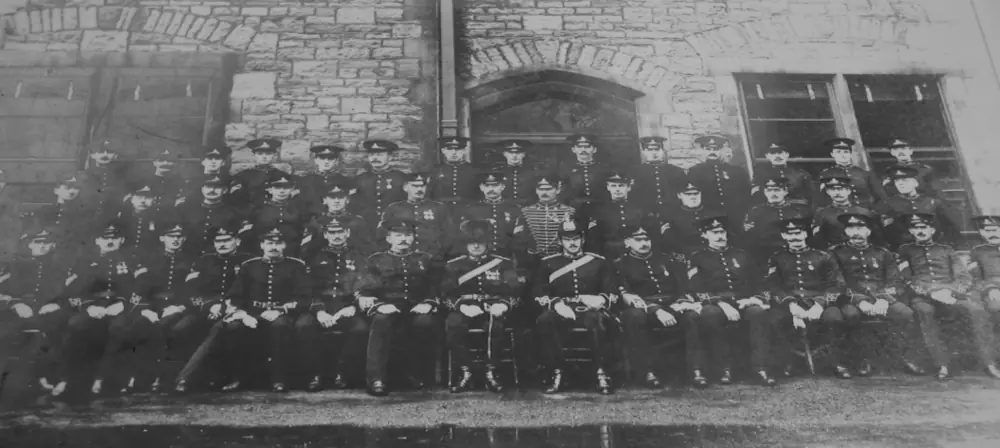
Sgt’s Mess with guest’s the Colonel and Adjutant, around 1912
Notice the two officers, one is wearing a Busby and the other one is wearing the police type helmet. The helmet [regulars only] did not come into use before 1902.
In October 1917. King George V was pleased to approve of the units of Territorial Force being allowed to wear the mottoes and honours of their corps, regiment or department in consideration of their service during the war, and from that date the territorial gunner has worn R.A. badges.
In 1921 the Territorial Force became the Territorial Army, many Yeomanry units were converted to gunners and by 1939 several T.A. infantry battalions were converted also. In 1940 the letter "T" ceased to be worn by officers and other ranks, shoulder chains are worn in No1 dress by some of the convert Yeomanry regiments. After WWII, the T.A. and GVA went through many changes in establishment and role.
Shoulder Titles
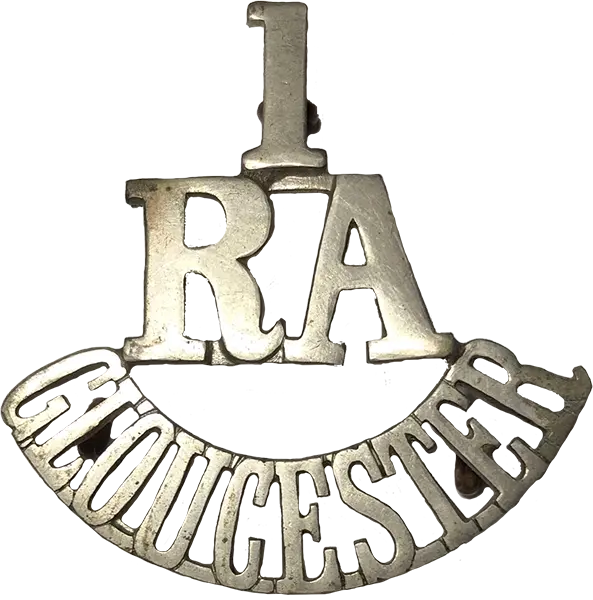
1 RA Gloucester pre 1908 white metal shoulder title shoulder title
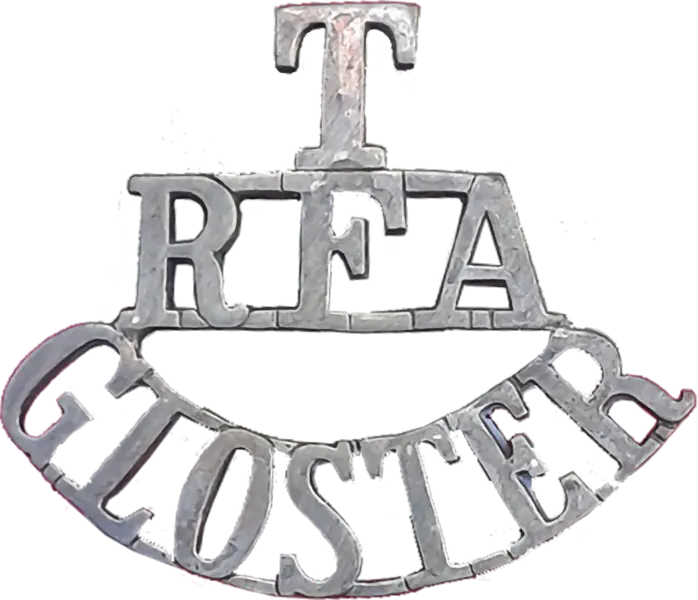
Gloucestershire Territorials Royal Field Artillery white metal shoulder title shoulder title
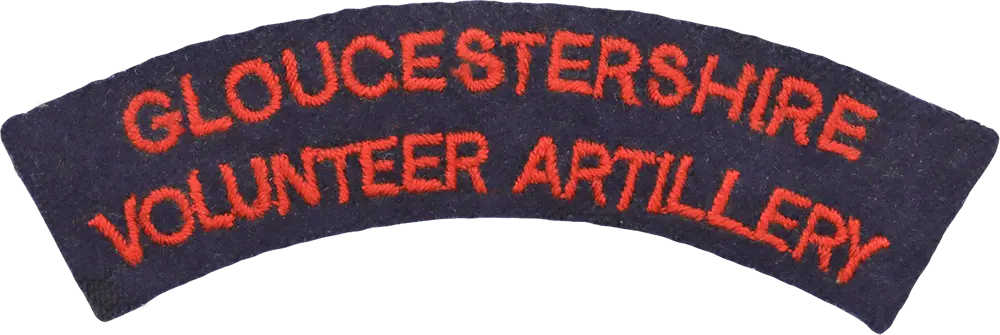
Gloucestershire Volunteer Artillery shoulder title. These were in use from 1961 to 1967
Sources and Resources
Derek Driscoll's original pages
Formation of the Gloucestershire Volunteer Artillery
Historical-Records-1859-1914 (PDF, 3.64Mb)
Dress of the Royal Artillery Volunteers from 1859
Dress of the Royal Artillery Volunteers from 1859
Other Resources
Austrian knot - Wikipedia
Busby (military headdress) - Wikipedia
The Dress of the Royal Artillery by Major D. Alastair Campbell RA, Arms and Armour Press
The History of the Dress of the Royal Regiment of Artillery 1625-1807 by Captain R. J. MacDonald RA, Crecy Books
The Volunteer Artillery - Uniformology
The Volunteer Artillery 1859-1908 by Norman Litchfield and Ray Westlake, Sherwood Press
Uniforms of the British Army - Wikipedia
